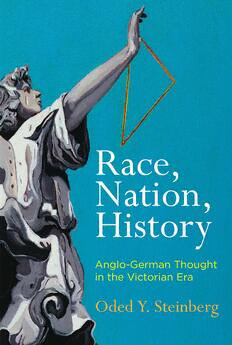
Race, Nation, History: Anglo-German Thought in the Victorian Era PDF
Preview Race, Nation, History: Anglo-German Thought in the Victorian Era
RACE, NATION, HISTORY INTELLECTUAL HISTORY OF THE MODERN AGE Series Editors Angus Burgin Peter E. Gordon Joel Isaac Karuna Mantena Samuel Moyn Jennifer Ratner- Rosenhagen Camille Robcis Sophia Rosenfeld R ACE, NATION, HISTORY Anglo- German Thought in the Victorian Era Oded Y. Steinberg University of Pennsylvania Press Philadelphia Copyright © 2019 University of Pennsylvania Press All rights reserved. Except for brief quotations used for purposes of review or scholarly citation, none of this book may be reproduced in any form by any means without written permission from the publisher. Published by University of Pennsylvania Press Philadelphia, Pennsylvania 19104-4112 www . upenn . edu / pennpress Printed in the United States of Amer i ca on acid- free paper 1 3 5 7 9 10 8 6 4 2 A Cataloging- in- Publication record is available from the Library of Congress ISBN 978-0-8122-5137-1 As you set out for Ithaka hope the voyage is a long one, full of adventure, full of discovery. — Cavafy, Ithaka, 1911 For my fellow and beloved travelers: Rachel, Nadav, Ayala, and Carmel Contents Introduction. Racial Time 1 Chapter 1. The En glish Teutonic Circle 21 Chapter 2. Roman Decline and Teutonic Rejuvenation: The Racial German and En glish Gemeinschaft of Scholars (1850–90) 50 Chapter 3. Racial History: The Convergence of Race and Periodization 89 Chapter 4. The Unique Historical Periodization of E. A. Freeman 109 Chapter 5. Teutonism and Romanism: James Bryce’s Holy Roman Empire 134 Chapter 6. The Illusion of Finality: Bury and the Unity of the East 157 Epilogue. Values and Interests 189 Notes 195 Bibliography 233 Index 253 Acknowl edgments 269 introduction Racial Time History can only exist as a discipline if it develops a theory of periodization. — Reinhart Koselleck Reinhart Koselleck h ere summarizes the method of history that materialized in the Enlightenment and was further developed during the nineteenth century. With this idea of the period, the division of historical time became dominant. For the first time, according to Koselleck, concepts (Begriffe) such as the M iddle Ages or the Ren ais sance became associated with a unique and demarcated historical era. Indeed, it could be argued that this development in the classification of time contributed to the establishment of history as a profession or even as an in de pen dent discipline. History suddenly possessed borders. These “borders of time” defined the main division of history into three demarcated periods: antiquity, M iddle Ages, and modernity. This Eurocentric triad dominates our general perception of historical time and corresponds with the division between antiquity, feudalism, and capitalism. It does not, as Jack Goody notes, take into consideration other “spaces” or “times” of non- European civilizations.1 In the modern era, to use this dominant Eurocentric periodization, especially because of the tendency to trace modernity’s own alleged origin, this division became almost sanctified and could be referred to as the historiographical “Holy Trinity.” Periodization arose as a concept in the nineteenth c entury si mul ta neously with the emergence of two other, sometimes amalgamated terms: “nation” and “race.” The significance of nationalism (as a concept), some argue, remained almost unnoticed by nineteenth- century scholars. For instance, Isaiah Berlin 2 introduction argues that, with the exception of Moses Hess in his Rome and Jerusalem (1862), no nineteenth- century con temporary thinker considered nationalism as the po liti cal force of the f uture.2 Whether or not one accepts Berlin’s assertion, his argument seems plausible in the sense that, for most nineteenth- century scholars, nationalism was conceived as merely another stage in h uman pro- gress. This stage corresponded with the basic natu ral feeling of belonging to a certain community, or Gemeinschaft. It could be argued that “race,” like “nation,” was also not identified as a distinct concept until the twentieth century. However, especially following the “Darwinian revolution” of the 1860s, a somewhat unique and allegedly scientific character was given to the notion of “race” by late nineteenth- century scholars. Thus, it may be argued, the concepts of “race” and “periodization” w ere transformed during the nineteenth century.3 The pres ent book proposes a novel thesis as to how historical periodiza- tion converged with racial, national, and religious themes and came to inform the historical perception of certain notable En glish and German scholars during the second half of the nineteenth century.4 The argument is developed by way of the exploration of two interlinked themes: how a specific group of En glish and German scholars employed the Teutonic notion to construct their past and pres ent communities; and, given this notion, how some of the En glish scholars came to perceive historical periodization. In light of t hese two themes, the book is divided into two interlinked parts: “community” and “time.” “Community” engages with a particularly close community—or Gemeinschaft— of En glish and German scholars that emerged around the middle of the nineteenth century. On the En glish side, this community included Edward Augustus Freeman (1823–92), William Stubbs (1825–1901), John Richard Green (1837–83), and James Bryce (1838– 1922). On the German side, it comprised scholars deeply involved with En- glish scholarship, like Christian Karl Josias von Bunsen (1791–1860), Reinhold Pauli (1823–82), and fi nally the renowned, almost En glish, Oxford scholar Friedrich Max Müller (1823–1900). Building on the notion of Teutonic kinship, this community of scholars founded an imagined community of belonging, composed of several subnations that were nevertheless understood to be united by racial, ethnic, and cultural bonds. Hence, England’s dominant Anglo- Saxons— namely, the retrospective identification of the Germanic Saxons, Angles and Jutes as the nation’s ancestors (Chapter 1)— were imagined to have racially united most of the British Isles’ inhabitants (excluding the autoch- thonic Celts of Ireland, Wales, and Scotland) with the Germanic entities of
